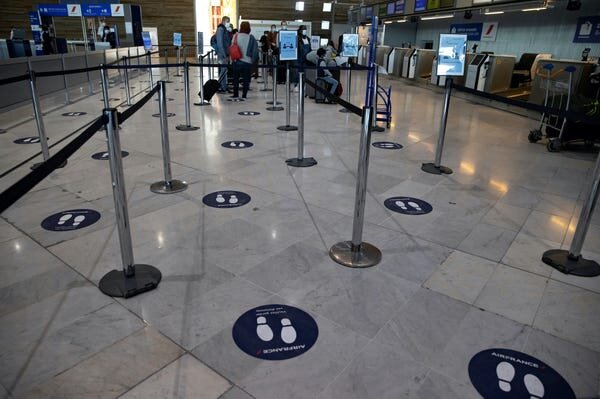The security screening process has been impacted significantly by the various COVID-19 measures such as physical distancing and health checks. However currently, due to a very minimal presence of passengers at the airport, these radically reduced process capacities are not perceived to be a big problem. Not yet. But what will happen when passenger numbers grow whilst the process will continue to operate at a new baseline? In this blogpost, Point FWD share their insights and views on main impact factors of COVID-19 on the security process, and how to approach successful recovery of operations.
Physical distancing throughout the airport
Physical distancing is a challenge throughout the entire airport. For security screening, the first challenge can be encountered when entering the queue for security. Due to physical distancing, passengers take up more space, reducing the capacity of the queue.
The same applies for queues, buffers and positions within the security checkpoint. Divest and reclaim positions may be closed to ensure sufficient physical distance, decreasing both process capacities. Another factor that could have impact; if a 1st divest position is occupied and the 3rd position is available, a waiting passenger may still not be able/wanting to pass, causing a parallel divest to become a rather serial process. As active assignment by an officer is not recommended, automatic assignment systems could assist in directing the passengers in a controlled manner.
Communication will remain a key focus in security.
Wearing facemasks can impact communication significantly, as the major component of communication between two persons is non-verbal. Due to a lower sound level and a lack of visible articulation, communication can be perceived to be harder. Especially with language barriers present in security checkpoints. Communicating within the security checkpoint can therefore take up more time to be successful. Of course, this applies to all processes in where operator-passenger interaction is essential and in general, these marginal time differences will have impact when passenger numbers will increase again.
Another example; when it becomes harder to successfully communicate, un-divested items in pockets can lead to higher passenger screening alarm rates, resulting in an increase of additional screening and re-divestment. Knowing where communication is impacted most is key to start improving the process at hand. Trials of deploying video instruction systems at divest show how to communicate this message successfully, even without personnel being physically present.
CONOP changes that impact capacity
Temporary CONOP changes to minimize physical contact with the passenger and baggage can influence process capacity. Alarms at passenger screening can be resolved by re-divesting and re-scanning the passenger, therewith minimizing the number of searches. Additionally, divest operators could be instructed to take more time explaining a passenger what to divest. This decreases divest capacity, but aims to decrease alarm percentage so that the number of trays needed to be manually checked can be minimized.
Another CONOPs change to consider; operators are required to change gloves, or disinfect regularly, specifically after physical interaction. When passenger numbers increase again, the time an operator spends doing this, is time not spent on processing passengers, thus decreasing capacity. EDS CB equipment can play a role in optimising this process, as there is a decreased need (depending on the type of EDS CB) to divest items from the baggage and the need for manual searches.
Process insight is the way towards a successful restart.
Point FWD advises airports and security companies to identify the impact of COVID-19 on their unique security environments and to start preparing for increased passenger numbers. Each change, whether it is a change in COVID-19 measures or a decision to accelerate implementation of CT, will result in a new process situation with altered behavior. Continuously capturing essential process data is key in getting control over the changing situation, enabling prompt identification of process bottlenecks and therewith the initiation of CONOPs experiments or technological implementations to successfully restart security operations.
Explore what Point FWD has to offer in gaining accurate security process insights, focusing on a step-by-step recovery approach for security operations.
Visit our Checkpoint Insight Tool page for more info, or send an information request via the button below.




